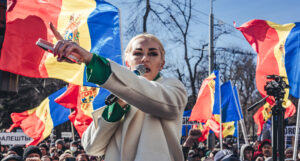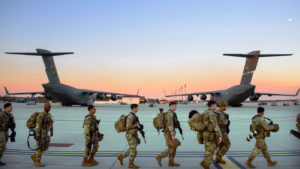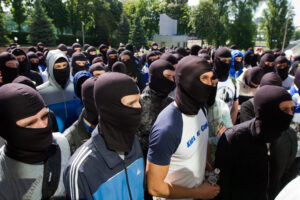The states of the former Soviet sphere have been trying to shrug off the “Eastern Europe” label for years. The term brings to mind tired stereotypes about an impoverished, illiberal post-communist East, which are for the most part tired and stale, and worse, liken eastern European nations to Russia — the ultimate slight. For countries such as Poland, Czechia, and Estonia, which have taken great strides economically to escape their socialist and communist pasts, the term no longer reflects reality.
In many ways, they’re right. In any tangible, geographic sense, Eastern Europe does not exist as a single entity and never has done. And thanks to the expansive, if uneven, impact of European integration since the early 2000s, nations from the former Soviet bloc are becoming less and less outwardly distinguishable from their Western neighbours. But still, I’ve always had a sense that something changes when one moves east across the Oder and Danube Rivers, though it’s not something that’s immediately apparent.
The feeling has grown sharper since the outbreak of war in Ukraine, as eastern European nations have increasingly operated as a united bloc. Last week, a row over Ukrainian grain erupted, as Poland, Hungary, Slovakia, and Bulgaria simultaneously imposed import bans to the dismay of Brussels. The week before, several eastern European leaders and diplomats, including Poland’s prime minister, directly challenged French President Emmanuel Macron’s suggestion that Europe should abandon its close ties with the United States.
But the region’s bonds run deeper than politics, which is why reflexive reactions against the term “Eastern Europe” are ultimately short-sighted. As a Pole, I am almost certainly in the minority in thinking that there is something deep within the collective memory of Eastern Europe that colours our understanding of the world, making it radically distinct from that of Western Europeans. With only a few outliers, eastern European nations have stood up to Russia and supported Ukraine’s war effort with great vigour. There’s a reason for this: it’s because we understand exactly what it’s like to be where Ukraine is today.
As I see it, “Eastern Europe” is a historical experience — one that stems from the indignity of domination by foreign powers, sacrifices made to win national freedoms and personal liberties, and the traumatic legacies of ethnic conflicts that remind us that we remain beholden even now to the brutal vagaries of human history. Perhaps the most fundamental building block in the Eastern European edifice, forged in the fires of centuries of subjugation, is the sense that resistance in the face of foreign oppression is worthwhile even if failure seems all but guaranteed. This idea has long shaped Eastern Europeans’ views of much of their past. National myth-makers in Serbia, for instance, have interpreted events as far back as the 1389 Battle of Kosovo — in which Serbian defenders valiantly wore down Ottoman invaders but were unable to stop the Turks’ eventual conquest of their lands — through the lens of noble struggle.
For the same reason, the 1944 Warsaw Uprising against Nazi German occupiers during the Second World War has become a cornerstone of modern Polish nationalism, even though it ultimately failed to liberate the country’s capital. And in February of last year, despite near-universal predictions that Kyiv would fall to the overwhelming might of the Russian military in a matter of days, Ukrainians chose to stand and fight anyway. This act of renegade heroism may be difficult for someone to fully grasp if they aren’t from Eastern Europe.
Largely because of the post-war Soviet sphere of influence over the region, Eastern Europe has long been identified with Russia. However, the term “Eastern Europe” has constantly been redefined throughout the ages, and there is no reason why its negative association with a bygone era should stop us doing so again. In reclaiming “Eastern Europe” for the 21st century, we must conclusively divorce it from Moscow, whose cultural, linguistic, and political ties to Eastern Europe have long masked its distinct and often hostile relationship to the region. The invasion of Ukraine is as good an excuse as any to cast off this veil once and for all.
As early as the Middle Ages, a delineation between East and West on the European continent existed in the form of medieval religious spheres of influence. The schism between Roman Catholicism and Eastern Orthodoxy created the first iteration of the idea of Eastern Europe, although its western boundary lay much further to the east than it does today, and its territory extended from Russia all the way down to Greece and Asia Minor.
By the 18th century, Moscow had transformed from an equal player in Eastern Europe to one of its overlords. Russia, alongside Prussia, the Habsburg Monarchy, and the Ottoman Empire, dominated the Eastern Europe we know today, and if one looks at a map of Europe in the year 1800, not a single country that exists today between the Oder and the Don Rivers was spared from imperial hegemony.
Around that time, Western European Enlightenment ideologues redefined “Eastern Europe” to suit their own ends and began to conceive of eastern territories as backward, unenlightened places. Western travellers to the region sent unflattering reports home: upon stepping into Poland, Marquis Louis-Philippe de Ségur, the French ambassador to Russia in the 1780s, said he felt like he had “moved back ten centuries”. Russia, despite being a great imperial power that had made a concerted effort to import French fashion, art, and culture, was not spared similar mockery.
Whereas the Enlightenment looked down upon Eastern Europe, the Romantic Movement that followed cultivated anti-imperial nationalisms across the region, which in turn fuelled several uprisings in Poland, the Hungarian Revolution of 1848, and the Balkan Wars in 1912 and 1913. These revolts inaugurated a defining trope of popular struggle against powerful oppressors that would unite the Eastern European experience for years to come while notably excluding Russia, whose national narrative was complicated by its status as one of the very empires Eastern Europeans were fighting to shake off.
The victory of the Entente in the First World War catalysed the transformation of these national movements into states, largely due to US President Woodrow Wilson’s decisive role at Versailles. The regional response to this occasion was hardly unanimous — Hungary, which separated from Austria but lost territory in the process through the infamous 1920 Treaty of Trianon, felt short-changed after the war. But despite never stepping foot in the region, Wilson and his Fourteen Points decided its future for the next two decades, redefining Eastern Europe as a dynamic experiment in self-determination — at least on paper.
Wilson’s victory lap however was short-lived, as Eastern Europe’s brutal 20th century attests to. Almost immediately after the cessation of hostilities in 1918, aspiring independence efforts in Ukraine were squashed by the Bolsheviks. From the Baltics in the north to Romania and the Balkans in the south, Eastern European nations ripped up Wilson’s noble ideas and took up arms against each other. The Second World War not long afterwards once again exposed the region to the terrors of foreign occupation at the hands of either the Nazis, the Soviets, or the Italians, incentivising eastern Europeans to resist their oppressors with even greater ferocity than before. It was no mistake that Nazi Germany attacked Poland first — in addition to being home to Europe’s largest Jewish population, it was Hitler’s gateway to the savage, subhuman East he so wished to subjugate.
Against this backdrop, genocide and ethnic cleansing reared its ugly head, most notably during the Holocaust, which was carried out primarily on Eastern European soil with varying degrees of complicity from local populations. Ukrainian UPA paramilitaries also waged ethnic cleansing campaigns against Poles during the war, as did Croat Ustaše forces against ethnic Serbs, and Serbian chetniks against Croats and Muslims. Decades later, genocide characterised the Yugoslav Wars of the Nineties and continues to this day to define Russia’s ongoing war in Ukraine.
The Soviet-backed Cold War regimes established after the war came to define the idea of Eastern Europe we are most familiar with today. Yet, while the Iron Curtain’s scars remain visible across the region, the days when Communism could be considered synonymous with Eastern Europe are long gone, giving way instead to the economic dynamism and immense diversity that now shines through the former-Warsaw Pact veneer.
But the common historical threads that bind Eastern Europe’s countries and peoples can be appreciated without diminishing their distinct national characteristics, political orders, and cultures. A new definition of “Eastern Europe” is vital if we are to understand how this new epoch fits into our collective past. Yet it fulfils a function for Western Europeans too. Eastern Europe’s defiant attitudes can come across as stubborn and obstinate. But now that we have seen how the horrors of the past can consume the Continent once again, Eastern Europe’s wisdom and predilection for resistance could prove indispensable.
Disclaimer
Some of the posts we share are controversial and we do not necessarily agree with them in the whole extend. Sometimes we agree with the content or part of it but we do not agree with the narration or language. Nevertheless we find them somehow interesting, valuable and/or informative or we share them, because we strongly believe in freedom of speech, free press and journalism. We strongly encourage you to have a critical approach to all the content, do your own research and analysis to build your own opinion.
We would be glad to have your feedback.
Source: UnHerd Read the original article here: https://unherd.com/





